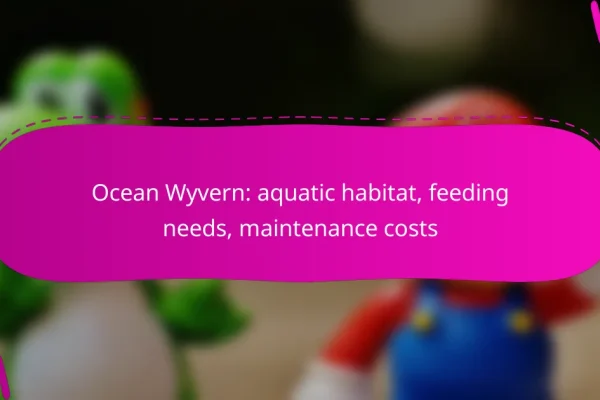What are the costs of owning Wyvern models?
Owning Wyvern models involves several costs that can vary significantly based on usage, model type, and location. Key expenses include the initial purchase price, maintenance, insurance, and operating costs, along with potential financing options.
Initial purchase price
The initial purchase price of Wyvern models can range from tens of thousands to several million dollars, depending on the model and specifications. Buyers should consider not only the base price but also any additional features or customizations that may increase the overall cost.
It’s advisable to research various models and compare prices from different dealers to find the best deal. Additionally, keep in mind that prices may fluctuate based on market demand and availability.
Maintenance expenses
Maintenance expenses for Wyvern models typically include routine inspections, repairs, and parts replacement. Annual maintenance costs can range from a few thousand to tens of thousands of dollars, depending on the model’s complexity and usage frequency.
Regular maintenance is crucial to ensure safety and optimal performance. Owners should budget for unexpected repairs, which can arise from wear and tear or operational mishaps.
Insurance costs
Insurance costs for Wyvern models can vary widely based on factors such as the model’s value, usage, and the owner’s location. Annual premiums may range from several thousand to tens of thousands of dollars, depending on coverage levels and risk factors.
It’s essential to shop around for insurance providers and compare quotes to find the best coverage at a reasonable price. Ensure that the policy covers all potential risks associated with ownership and operation.
Operating costs
Operating costs include fuel, pilot salaries, and other operational expenses. These costs can add up quickly, with fuel expenses alone potentially reaching thousands of dollars per flight, depending on distance and fuel prices.
Owners should also consider additional costs such as hangar fees, ground crew salaries, and maintenance supplies. Keeping a detailed budget for these expenses can help manage overall ownership costs effectively.
Financing options
Financing options for purchasing Wyvern models typically include loans, leases, or fractional ownership arrangements. Loan terms can vary, with interest rates influenced by credit scores and the model’s value.
Leasing may offer lower upfront costs and flexibility but can result in higher long-term expenses. Fractional ownership allows multiple owners to share costs and usage, making it a viable option for those who may not need full-time access.
How do logistics impact Wyvern model ownership?
Logistics play a crucial role in Wyvern model ownership, affecting costs, accessibility, and overall management. Effective logistics ensure timely delivery, adequate storage, and efficient transportation, which are essential for maintaining the models’ condition and usability.
Shipping and delivery options
When acquiring Wyvern models, consider various shipping and delivery options that suit your needs. Standard shipping may take several days, while expedited services can reduce delivery time significantly, often to 1-2 days. It’s important to compare costs and delivery times from different carriers to find the best fit for your budget and urgency.
Additionally, ensure that the shipping method you choose complies with any regulations regarding the transport of specialized models. Some carriers may offer insurance for high-value items, which can provide peace of mind during transit.
Storage requirements
Proper storage is vital for preserving the integrity of Wyvern models. Depending on the size and complexity of the models, you may need a dedicated space that maintains a stable temperature and humidity level. Ideally, storage areas should be free from direct sunlight and excessive dust to prevent damage.
Consider using protective cases or shelving designed for model storage to keep them organized and safe. Regularly inspect the storage environment to ensure it remains suitable for the models’ needs.
Transportation logistics
Transportation logistics involve planning how to move Wyvern models from one location to another, whether for events, exhibitions, or maintenance. Evaluate the best vehicles for transport, ensuring they can accommodate the models without risk of damage. Using padded containers or custom supports can help secure the models during transit.
Additionally, factor in the distance and route when planning transportation. Shorter routes may reduce the risk of damage, while longer journeys may require more detailed planning, including rest stops and handling protocols. Always have a contingency plan in case of delays or unexpected issues during transport.
What are the best practices for maintaining Wyvern models?
To maintain Wyvern models effectively, establish a routine maintenance schedule, utilize qualified service providers, and be aware of common repair issues. These practices ensure optimal performance and longevity of the models.
Regular maintenance schedule
A regular maintenance schedule is crucial for keeping Wyvern models in top condition. Aim for inspections every few months, focusing on key components such as the propulsion system and structural integrity. Seasonal checks can help identify issues before they escalate.
Consider creating a checklist for each maintenance session, including tasks like cleaning, lubricating moving parts, and checking for wear and tear. This structured approach minimizes the risk of overlooking critical maintenance tasks.
Recommended service providers
Selecting the right service providers is essential for effective maintenance and repairs of Wyvern models. Look for certified technicians who specialize in these models and have a solid reputation in the industry. Checking reviews and asking for recommendations can help you find reliable experts.
Additionally, consider service providers that offer warranties on their work. This not only ensures quality repairs but also provides peace of mind regarding future issues that may arise.
Common repair issues
Common repair issues with Wyvern models often include engine malfunctions, electrical system failures, and structural damage. Regular inspections can help catch these problems early, but being aware of their signs is equally important.
For instance, unusual noises from the engine or fluctuating performance can indicate underlying issues that require immediate attention. Addressing these problems promptly can prevent more extensive damage and costly repairs down the line.
What financing options are available for Wyvern models?
Financing options for Wyvern models typically include leasing, loans, and potential government grants. Each option has its own advantages and considerations, making it essential to evaluate which method aligns best with your financial situation and usage needs.
Leasing vs. buying
Leasing a Wyvern model allows you to use the aircraft without the upfront costs associated with purchasing. This option often includes maintenance and service, making it a more predictable expense over time.
Buying, on the other hand, requires a significant initial investment but provides full ownership and potential asset appreciation. Consider your long-term plans and how frequently you intend to use the model when deciding between these two options.
Loan options
Various lenders offer loans specifically for aircraft purchases, including banks and specialized aviation finance companies. Interest rates can vary widely, typically ranging from low to mid-single digits, depending on your creditworthiness and the loan terms.
When applying for a loan, be prepared to provide detailed financial information and a business plan if applicable. Ensure you understand the total cost of the loan, including any fees or insurance requirements.
Government grants and incentives
Some regions may offer grants or incentives for purchasing or leasing Wyvern models, particularly if they are used for commercial purposes or contribute to environmental goals. Research local and national programs that might provide financial assistance.
Eligibility for these grants often depends on specific criteria, such as the intended use of the aircraft or compliance with environmental regulations. Check with local aviation authorities or government websites for the most current information on available programs.
What are the resale values of Wyvern models?
The resale values of Wyvern models can vary significantly based on factors such as condition, age, and market demand. Generally, well-maintained models retain a higher percentage of their original value, often ranging from 50% to 80% of the purchase price.
Market trends
Current market trends indicate a growing interest in Wyvern models, particularly among collectors and enthusiasts. This increased demand has led to a gradual rise in resale values over the past few years, with certain limited editions fetching premium prices.
Seasonal fluctuations can also impact resale values, with peak selling times typically occurring during trade shows or collector events. Keeping an eye on these trends can help sellers time their sales for maximum profit.
Factors affecting resale value
Several factors influence the resale value of Wyvern models, including condition, rarity, and historical significance. Models in pristine condition or those with unique features tend to command higher prices.
Additionally, the availability of parts and support for maintenance can affect buyer confidence, impacting resale values. Models that are easier to service or have a strong community support network often sell better.
Comparison with competitors
When comparing Wyvern models to competitors, it’s essential to consider the overall market positioning. While some brands may offer lower initial prices, Wyvern models often provide better long-term value due to their durability and resale potential.
For instance, models from competing brands may depreciate more quickly, with resale values dropping to 30%-50% of the original price within a few years. In contrast, Wyvern models typically hold their value better, making them a more attractive investment for buyers.















